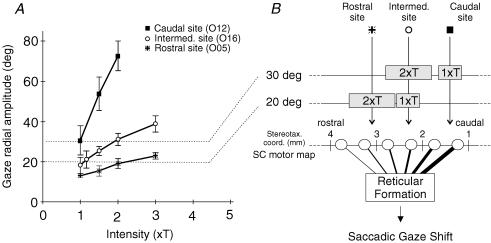Figure 1. Rationale of the study.
A, Effect of current intensity on the metrics of gaze shifts evoked from a rostral ( ), an intermediate (○) and a caudal (▪) collicular site. Gaze radial amplitude is plotted as a function of stimulation current intensity. This intensity is expressed relative to a threshold (T) defined as the intensity which evoked a gaze shift in >75% of stimulation trials. The frequency of stimulation was 300 pulse s−1 and its duration always outlasted the gaze shift duration in order to avoid movement truncation. Symbols represent means ±s.d.B, unidimentional representation of SC motor map and interpretation of the graph in A. The three collicular sites of graph A are positioned on the antero-posterior dimension of the SC (stereotaxic coordinates). Grey boxes correspond to the postulated size of collicular activations induced by the electrical stimulation. Open circles symbolize collicular output neurons. The projections of these neurons toward the reticular formation are symbolized by lines of increasing thickness to account for the known motor map organization (site-dependent encoding of gaze amplitude). The objective of the present study is to test whether gaze shifts of similar amplitude evoked from remote SC sites (e.g. 20 deg gaze shifts from ○ and
), an intermediate (○) and a caudal (▪) collicular site. Gaze radial amplitude is plotted as a function of stimulation current intensity. This intensity is expressed relative to a threshold (T) defined as the intensity which evoked a gaze shift in >75% of stimulation trials. The frequency of stimulation was 300 pulse s−1 and its duration always outlasted the gaze shift duration in order to avoid movement truncation. Symbols represent means ±s.d.B, unidimentional representation of SC motor map and interpretation of the graph in A. The three collicular sites of graph A are positioned on the antero-posterior dimension of the SC (stereotaxic coordinates). Grey boxes correspond to the postulated size of collicular activations induced by the electrical stimulation. Open circles symbolize collicular output neurons. The projections of these neurons toward the reticular formation are symbolized by lines of increasing thickness to account for the known motor map organization (site-dependent encoding of gaze amplitude). The objective of the present study is to test whether gaze shifts of similar amplitude evoked from remote SC sites (e.g. 20 deg gaze shifts from ○ and  sites) have similar kinematics and eye–head coordination pattern.
sites) have similar kinematics and eye–head coordination pattern.

